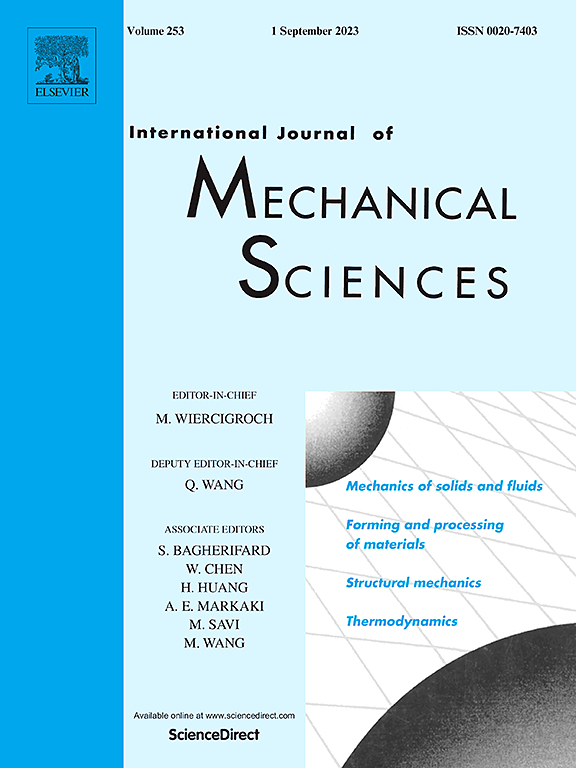A re-evaluation of super-high ductility mechanism in superplastic uniaxial tension
IF 7.1
1区 工程技术
Q1 ENGINEERING, MECHANICAL
International Journal of Mechanical Sciences
Pub Date : 2025-02-13
DOI:10.1016/j.ijmecsci.2025.110059
引用次数: 0
Abstract
Existing mechanical theories fall short in explaining the origin of delocalization behavior and the associated fluctuation phenomena observed in superplastic quasi-stable tension, which typically results in extraordinarily high fracture elongation. This study introduces a novel phenomenological model that accounts for the stick-slip effect arising from discontinuities in grain boundary sliding (GBS) during superplastic deformation. Experimental observations from uniaxial tension tests on a Zn-5Al superplastic alloy at 230 °C validate the accuracy of the simulations, which demonstrate static-kinetic coordinated deformation during each serrated fluctuation. Additionally, the simulations indicate that the stick-slip effect triggers dynamic delocalization behavior in superplastic tension, elucidating the nucleation and growth of additional micro-necks. Although this dynamic delocalization disrupts the initially stable flow, it significantly mitigates the development of macro-necks during unstable plastic flow, potentially leading to quasi-stable tensile deformation devoid of prominent macro-necks as the stick-slip effect intensifies. Notably, this study identifies for the first time the phenomenon of stress reduction during superplastic tension with jerky flow, attributable to an oscillatory stress induced by the GBS stick-slip effect superimposed on a static stress backdrop. The combined effects of GBS-induced stick-slip behavior and high strain rate sensitivity contribute to the extraordinarily large elongations observed in superplastic tension. Overall, the phenomenological model developed in this work not only clarifies the mechanical reasons behind specific phenomena in superplastic uniaxial tension, often overlooked by conventional mechanical analyses, but also proposes a new approach to enhancing superplastic deformation.

求助全文
约1分钟内获得全文
求助全文
来源期刊

International Journal of Mechanical Sciences
工程技术-工程:机械
CiteScore
12.80
自引率
17.80%
发文量
769
审稿时长
19 days
期刊介绍:
The International Journal of Mechanical Sciences (IJMS) serves as a global platform for the publication and dissemination of original research that contributes to a deeper scientific understanding of the fundamental disciplines within mechanical, civil, and material engineering.
The primary focus of IJMS is to showcase innovative and ground-breaking work that utilizes analytical and computational modeling techniques, such as Finite Element Method (FEM), Boundary Element Method (BEM), and mesh-free methods, among others. These modeling methods are applied to diverse fields including rigid-body mechanics (e.g., dynamics, vibration, stability), structural mechanics, metal forming, advanced materials (e.g., metals, composites, cellular, smart) behavior and applications, impact mechanics, strain localization, and other nonlinear effects (e.g., large deflections, plasticity, fracture).
Additionally, IJMS covers the realms of fluid mechanics (both external and internal flows), tribology, thermodynamics, and materials processing. These subjects collectively form the core of the journal's content.
In summary, IJMS provides a prestigious platform for researchers to present their original contributions, shedding light on analytical and computational modeling methods in various areas of mechanical engineering, as well as exploring the behavior and application of advanced materials, fluid mechanics, thermodynamics, and materials processing.
 求助内容:
求助内容: 应助结果提醒方式:
应助结果提醒方式:


